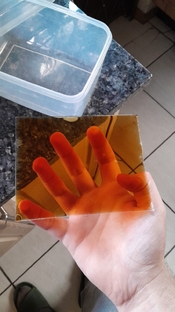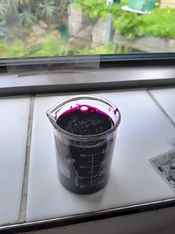Sparks n Fire
Member
Ever since I started making my own emulsion I've not been satisfied with with the softened edges around bright objects in the photo as a result of halation caused by internal reflection of the glass/acetate base. I've managed to find more than one book that cites the use of a 0.6% solution of potassium permanganate in gelatin coated before the emulsion. This stops the light from reaching the glass and gives nice crisp negatives.
The way I prepared this solution is I measured out 50ml of water and saved 10ml for the permanganate, added 4g of gelatin to make an 8% gelatin solution and allowed it to swell then heated it to dissolve. I then took the 10ml and added 0.3g of potassium permanganate and lightly heated it to make sure it all dissolved. I then combined the two solutions and it turned orangy-brown to make what I believe is manganese dioxide which is unable to leech through to the emulsion layer as a dye might do. I then dried the coating and poured emulsion on top. This manganese dioxide is destroyed in processing and is not visible when processed.
NB: It is important that everything be dissolved before mixing because i tried swelling the gelatin in the potassium permanganate solution which resulted in the gelatin absorbing a lot of the permanganate and not swelling. resulted in a mess when trying to melt and coat.
I've only tested 1 plate with this but the effect is quite evident if you look in the right places. Ive attached the photos of the tests i did.
This one is the plain emulsion coated on duralar. it has chrome alum which slowed the development and altered the contrast. The halation is most evident on the boarder of the image and where the flowers stick into the air, you can see the lines are a bit fuzzy.

this one is the glass plate coated with the A-H layer, you can see the lines are much cleaner. the contrast is stronger because it had a shorter development time due to no hardener. I didnt add any because I was doing a quick test.

here is the plate with just the A-H layer and the potassium permanganate before adding to the gelatin


I hope you guys find this little experiment helpful!
N.N
The way I prepared this solution is I measured out 50ml of water and saved 10ml for the permanganate, added 4g of gelatin to make an 8% gelatin solution and allowed it to swell then heated it to dissolve. I then took the 10ml and added 0.3g of potassium permanganate and lightly heated it to make sure it all dissolved. I then combined the two solutions and it turned orangy-brown to make what I believe is manganese dioxide which is unable to leech through to the emulsion layer as a dye might do. I then dried the coating and poured emulsion on top. This manganese dioxide is destroyed in processing and is not visible when processed.
NB: It is important that everything be dissolved before mixing because i tried swelling the gelatin in the potassium permanganate solution which resulted in the gelatin absorbing a lot of the permanganate and not swelling. resulted in a mess when trying to melt and coat.
I've only tested 1 plate with this but the effect is quite evident if you look in the right places. Ive attached the photos of the tests i did.
This one is the plain emulsion coated on duralar. it has chrome alum which slowed the development and altered the contrast. The halation is most evident on the boarder of the image and where the flowers stick into the air, you can see the lines are a bit fuzzy.
this one is the glass plate coated with the A-H layer, you can see the lines are much cleaner. the contrast is stronger because it had a shorter development time due to no hardener. I didnt add any because I was doing a quick test.
here is the plate with just the A-H layer and the potassium permanganate before adding to the gelatin


I hope you guys find this little experiment helpful!
N.N












